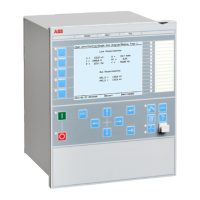under certain circumstances the fault condition may reoccur during the post-fault
recording, for instance by automatic reclosing to a still faulty power line.
In order to capture the new disturbance it is possible to allow retriggering (PostRetrig
= Enabled) during the post-fault time. In this case a new, complete recording will start
and, during a period, run in parallel with the initial recording.
When the retrig parameter is disabled (PostRetrig = Disabled), a new recording will
not start until the post-fault (PostFaultrecT or TimeLimit) period is terminated. If a
new trig occurs during the post-fault period and lasts longer than the proceeding
recording a new complete recording will be started.
Disturbance report function can handle maximum 3 simultaneous disturbance recordings.
12.3.7 Technical data
Table 227: DRPRDRE technical data
Function Range or value Accuracy
Current recording - ± 1,0% of I
r
at I ≤ I
r
± 1,0% of I at I > Ir
Voltage recording - ± 1,0% of V
n
at V≤ V
n
± 1,0% of Vat V> V
n
Pre-fault time (0.05–3.00) s -
Post-fault time (0.1–10.0) s -
Limit time (0.5–8.0) s -
Maximum number of recordings 100, first in - first out -
Time tagging resolution 1 ms See time synchronization
technical data
Maximum number of analog inputs 30 + 10 (external + internally
derived)
-
Maximum number of binary inputs 96 -
Maximum number of phasors in the Trip
Value recorder per recording
30 -
Maximum number of indications in a
disturbance report
96 -
Maximum number of events in the Event
recording per recording
150 -
Maximum number of events in the
Sequence of events
1000, first in - first out -
Maximum total recording time (3.4 s
recording time and maximum number of
channels, typical value)
340 seconds (100 recordings)
at 50 Hz, 280 seconds (80
recordings) at 60 Hz
-
Sampling rate 1 kHz at 50 Hz
1.2 kHz at 60 Hz
-
Recording bandwidth (5-300) Hz -
1MRK 505 277-UUS C Section 12
Monitoring
281
Technical Manual

